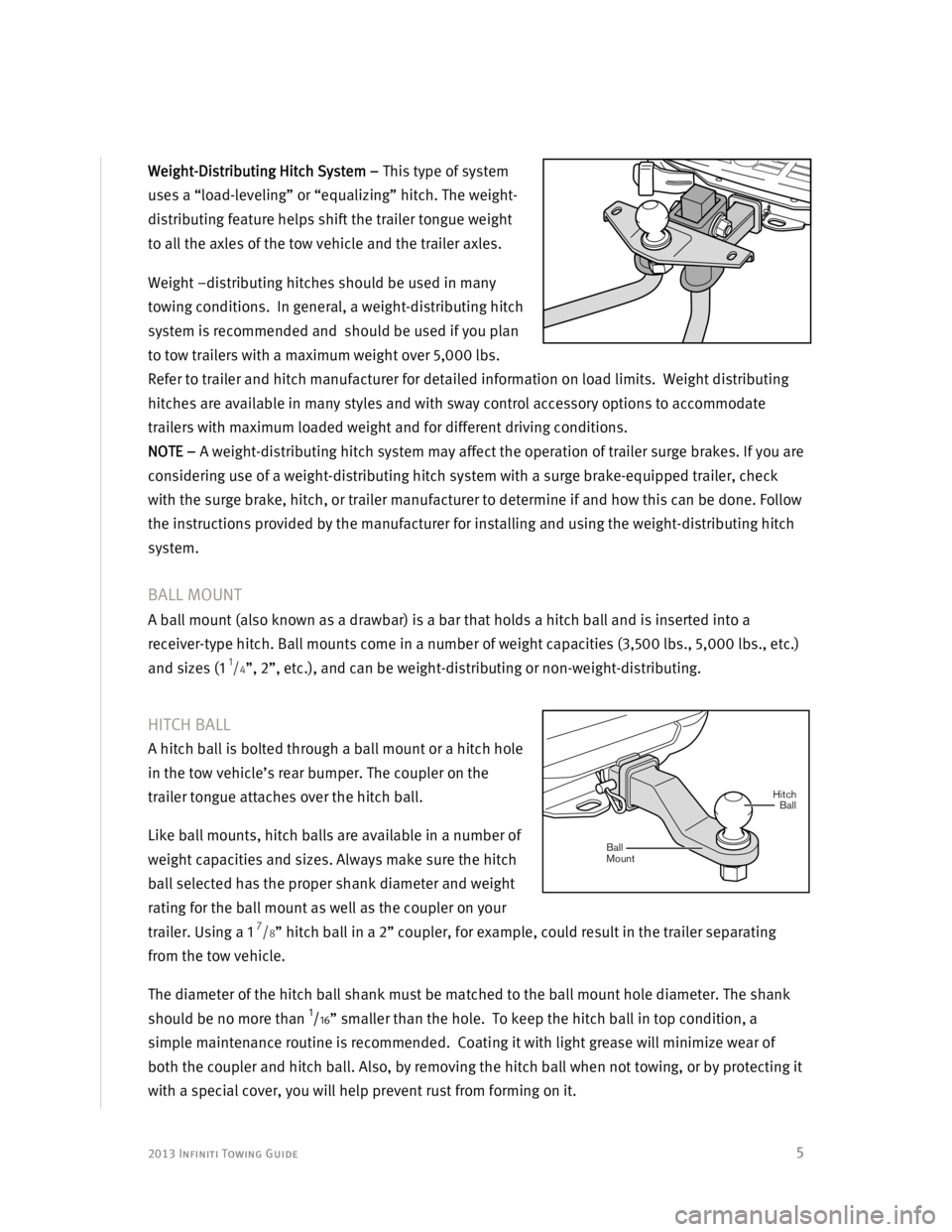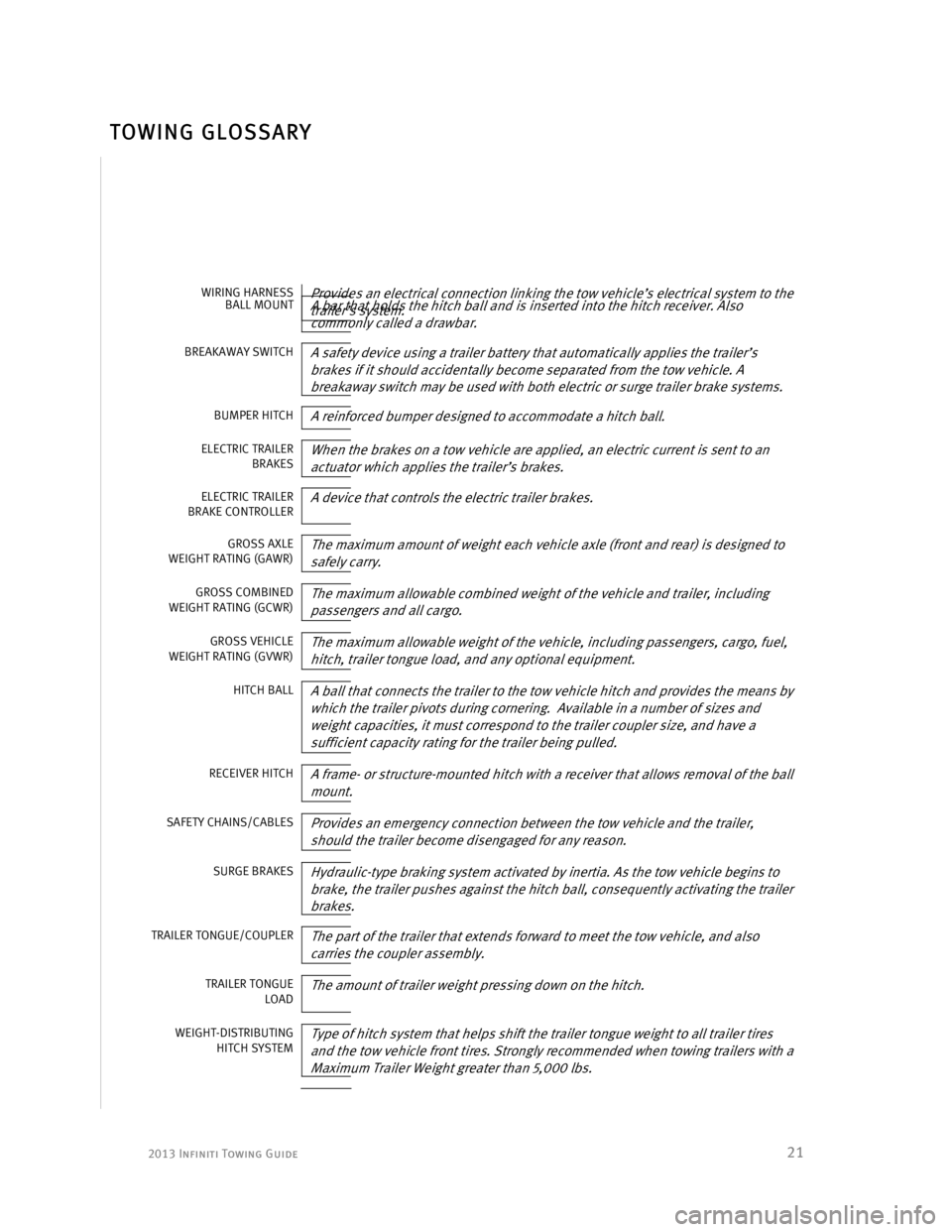tow bar INFINITI JX 2013 Towing Guide
[x] Cancel search | Manufacturer: INFINITI, Model Year: 2013, Model line: JX, Model: INFINITI JX 2013Pages: 25, PDF Size: 0.42 MB
Page 6 of 25

2013 Infiniti Towing Guide
5
Weight-Distributing Hitch System – This type of system
uses a “load-leveling” or “equalizing” hitch. The weight-
distributing feature helps shift the trailer tongue weight
to all the axles of the tow vehicle and the trailer axles.
Weight –distributing hitches should be used in many
towing conditions. In general, a weight-distributing hitch
system is recommended and should be used if you plan
to tow trailers with a maximum weight over 5,000 lbs.
Refer to trailer and hitch manufacturer for detailed information on load limits. Weight distributing
hitches are available in many styles and with sway control accessory options to accommodate
trailers with maximum loaded weight and for different driving conditions.
NOTE – A weight-distributing hitch system may affect the operation of trailer surge brakes. If you are
considering use of a weight-distributing hitch system with a surge brake-equipped trailer, check
with the surge brake, hitch, or trailer manufacturer to determine if and how this can be done. Follow
the instructions provided by the manufacturer for installing and using the weight-distributing hitch
system.
BALL MOUNT
A ball mount (also known as a drawbar) is a bar that holds a hitch ball and is inserted into a
receiver-type hitch. Ball mounts come in a number of weight capacities (3,500 lbs., 5,000 lbs., etc.)
and sizes (1
1/4”, 2”, etc.), and can be weight-distributing or non-weight-distributing.
HITCH BALL
A hitch ball is bolted through a ball mount or a hitch hole
in the tow vehicle’s rear bumper. The coupler on the
trailer tongue attaches over the hitch ball.
Like ball mounts, hitch balls are available in a number of
weight capacities and sizes. Always make sure the hitch
ball selected has the proper shank diameter and weight
rating for the ball mount as well as the coupler on your
trailer. Using a 1
7/8” hitch ball in a 2” coupler, for example, could result in the trailer separating
from the tow vehicle.
The diameter of the hitch ball shank must be matched to the ball mount hole diameter. The shank
should be no more than
1/16” smaller than the hole. To keep the hitch ball in top condition, a
simple maintenance routine is recommended. Coating it with light grease will minimize wear of
both the coupler and hitch ball. Also, by removing the hitch ball when not towing, or by protecting it
with a special cover, you will help prevent rust from forming on it.
Hitch
Mount BallBall
Page 22 of 25

2013 Infiniti Towing Guide
21
BALL MOUNT A bar that holds the hitch ball and is inserted into the hitch receiver. Also
commonly called a drawbar.
BREAKAWAY SWITCH A safety device using a trailer battery that automatically applies the trailer’s
brakes if it should accidentally become separated from the tow vehicle. A
breakaway switch may be used with both electric or surge trailer brake systems.
BUMPER HITCH A reinforced bumper designed to accommodate a hitch ball.
ELECTRIC TRAILER BRAKES When the brakes on a tow vehicle are applied, an electric current is sent to an
actuator which applies the trailer’s brakes.
ELECTRIC TRAILER BRAKE CONTROLLER A device that controls the electric trailer brakes.
GROSS AXLE WEIGHT RATING (GAWR) The maximum amount of weight each vehicle axle (front and rear) is designed to
safely carry.
GROSS COMBINED WEIGHT RATING (GCWR) The maximum allowable combined weight of the vehicle and trailer, including
passengers and all cargo.
GROSS VEHICLE
WEIGHT RATING (GVWR) The maximum allowable weight of the vehicle, including passengers, cargo, fuel,
hitch, trailer tongue load, and any optional equipment.
HITCH BALL
A ball that connects the trailer to the tow vehicle hitch and provides the means by
which the trailer pivots during cornering. Available in a number of sizes and
weight capacities, it must correspond to the trailer coupler size, and have a
sufficient capacity rating for the trailer being pulled.
RECEIVER HITCH A frame- or structure-mounted hitch with a receiver that allows removal of the ball
mount.
SAFETY CHAINS/CABLES Provides an emergency connection between the tow vehicle and the trailer,
should the trailer become disengaged for any reason.
SURGE BRAKES
Hydraulic-type braking system activated by inertia. As the tow vehicle begins to
brake, the trailer pushes against the hitch ball, consequently activating the trailer
brakes.
TRAILER TONGUE/COUPLER The part of the trailer that extends forward to meet the tow vehicle, and also
carries the coupler assembly.
TRAILER TONGUE
LOAD The amount of trailer weight pressing down on the hitch.
WEIGHT-DISTRIBUTING
HITCH SYSTEM Type of hitch system that helps shift the trailer tongue weight to all trailer tires
and the tow vehicle front tires. Strongly recommended when towing trailers with a
Maximum Trailer Weight greater than 5,000 lbs.
WIRING HARNESS
Provides an electrical connection linking the tow vehicle’s electrical system to the
trailer’s system.
TOWING GLOSSARY